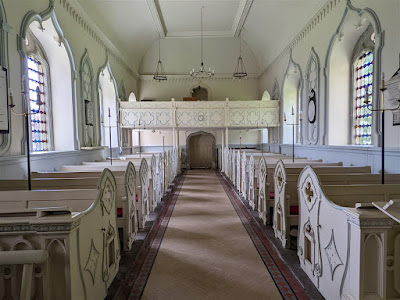Our next major destination after Wells was the Welsh castle Powis and its gardens. But an old favorite, the parish church of St. Mary and St. David in the hamlet of Kilpeck, in Herefordshire, was more or less on the way. One thing led to another and we detoured further to Shobdon and another parish church, or, rather, a relic from its predecessor, to be recounted in the next post.
Students of this blog know that Kilpeck, in 2009, was one of our seminal visits in both the UK and in our appreciation of Christian art and architecture: it was our introduction to what I've termed "funny faces," more formally known as "grotesques" or even "hunky punks" (in Somerset). A subsequent visit introduced us to the Herefordshire School of Romanesque Sculpture and the purchase and study of a book by that name by one Malcolm Thurlby. Relevant pix of the Kilpeck funny faces and commentary are in my posts from 2009 and 2016:
We got to Kilpeck, via many narrow "B" roads and country lanes, the afternoon of May 18th, and found the early 12th century church of St. Mary and St. David under scaffolding, three of the four exterior walls: roofing repairs underway. Were we not already well acquainted with the church and its sculptures, we would have been sorely disappointed. Less than a quarter of the funny faces were visible at all. But we were pleased to see the preservation work underway. Without adequate roofing, the funny faces would be even more exposed to the elements than in the past nine hundred years. We contributed generously (for us) to the preservation fund. On previous visits we were by ourselves, but this time there were several visiting parties and even a small tour bus that arrived as we were leaving. Disappointing for them, perhaps, but still enough to get the gist and wonder what the 12th century minds were thinking.
Our visit to Kilpeck was not without further discoveries. Sample copies of Thurlby's book, in two different editions, were on display in the church, and we noted that some past visitor had scribbled that the
Sheela-na-gig, among the funny faces, was a pagan thing and unfit for a Christian church. (Never mind how and why it got there...). Interestingly, this was in the first edition of the book. Mention of the Sheela-na-gig had disappeared entirely in the second edition! There are scores, maybe hundreds, of Sheela-na-gigs on churches throughout Europe, mostly Ireland, the UK, France and Spain. Christian "propriety" being what it is, we still marvel that any of them remain. See Barbara Freitag's
Sheela-Na-Gigs: Unraveling a Mystery (available free online) for much further information and interpretation.
 |
6 feet 6 inches wide, the sign said; not one-way either; actually
quite a bit of our driving has been on such roads recently; thankfully,
in this respect, we are no longer in a motor-home |
 |
Fortunately, several of the most popular
figures were clearly visible
|
 |
| Others, on the north side, not so much |
 |
| The famous Sheela-na-gig |
 |
| The beautiful door arch |
 |
| Interior carving |
 |
| The bescribbled page |
 |
| Nice Green Man...equally pagan, I might add |
 |
| Environs...nearly a Constable |
 |
| South and east sides completely closed off |
 |
But we're comforted to know it will still be there for others to
see, and wonder |





















































